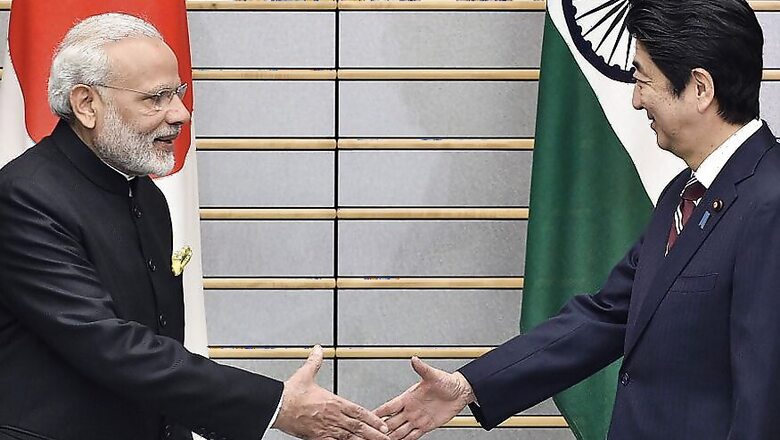
views
The just-concluded twelfth India-Japan annual summit was a blunt message to China. This was Narendra Modi and Shinzo Abe’s fourth consecutive meet and the former, in his own way, has conveyed to Beijing that New Delhi has allies, maybe not at the battlefront, but definitely in the international community.
The September 14 summit in Gandhinagar, Gujarat, was laden with strategic agenda and all of it related to intensifying relations between Asia's two major democracies, economies.
The two leading Asian powers whose bilateral interplay is among the most happening engagements on the world stage has a direct impact on the Asian giant and a near-superpower: China.
Here are five major takeaways from the summit:
DEFENCE: While the much-awaited deal on the purchase of ShinMaywa US-2 amphibious aircraft couldn’t be signed during this visit — it’s still a matter of when not if.
This breakthrough defence deal is a sign of the importance that Japan attaches to India considering the track record that the east-Asian country has not exported any sensitive defence-related equipment to any foreign country in the last 70 years.
The Japanese are by nature not defence material exporters either, a fact that was demonstrated last year when the multi-billion dollar deal with Australia for export of Soryu submarines fell through.
The joint statement released after the Modi-Abe summit in Gandhinagar gave an indication of the upcoming breakthrough over the aircraft deal. “Japan’s readiness to provide its state-of-the-art US-2 amphibian aircraft was appreciated as symbolising the high degree of trust between the two countries. The two governments decided to continue their discussions in this regard.”
STRATEGIC: Joint exercises and burgeoning strategic ties between India and Japan, with other powers like the United States and Australia, form the bedrock of fast expanding strategic relations between the two Asian powers.
Modi and Abe decided to take these strategic ties to an even higher trajectory. Consider the following clause from the joint statement: “The two Prime Ministers welcomed the recently held annual Defence Ministerial Dialogue and the first Defence Industry Forum in Tokyo on 5 September, which was addressed by the two Defence Ministers as well as the discussions covering other promising initiatives in defence industry cooperation. They recognised the importance of enhancing interactions between governments and defence industries of the two countries in order to encourage equipment collaboration including defence and dual-use technologies.”
INDIA’S NORTHEAST: Japan holds the unique distinction of being the only foreign power which is welcomed with open arms by India for the development of India’s north-eastern states and the Andaman and Nicobar Islands.
It’s not without reason that the Indo-Japan joint statement underlines the need for developing “smart islands” and improving the connectivity in all aspects. This has an undisclosed reference to Andaman and Nicobar Islands and what India, Japan may be planning together, with an eye on China, in these strategically located landmasses. As for the Indo-Japan joint plans with regard to the India’s northeast, consider the following clause of the joint statement: “The two Prime Ministers welcomed the India-Japan cooperation on development of India’s North Eastern Region (NER) as a concrete symbol of developing synergies between India’s Act East policy and Japan’s Free and Open Indo Pacific Strategy. In this context, they noted with satisfaction the setting up of the India-Japan Act East Forum. They appreciated the cooperation between Japan and North Eastern Region of India, ranging from key infrastructure such as road connectivity, electricity, water supply and sewage, to social and environmental sustainability such as afforestation and community empowerment, as well as people-to-people exchanges including the ‘IRIS Program’ inviting youth from the NER to Japan.”
BULLET TRAIN: The Mumbai-Ahmedabad High-Speed Rail (MAHSR) project was indubitably the biggest optic of the Modi-Abe summit. The two sides exchanged notes for 100 billion yen (900 million US dollars) as the first Official Development Assistance or ODA loan for the project.
The Japanese have extended a soft loan for 50 years at an unbelievable interest rate of 0.1% for the $16 billion project. The terms of the loan also carry a grace period of 10 years for repayment, demonstrating how intrinsically close the Japanese have become in uplifting India’s infrastructure.
TERRORISM: In a major brownie point to PM Modi, Shinzo Abe stood solidly with India on the issue of Pakistan-sponsored terrorism. The Japanese side, for the first time, referred to Pakistan-Based terror outfits in the joint statement. This should go a long way in aiding India’s attempts to isolate Pakistan in the international community. “PM Narendra Modi and PM (Shinzo) Abe look forward to convening (the) 5th Japan-India consultation on terrorism and to strengthen cooperation against terrorist threats from groups including Al-Qaida, ISIS, JeM, LeT and their affiliates,” said the joint statement.
This is the second in September when Pakistan has come under fire at an international summit for its sins of omission and commission on the terror issue. For the first time, the BRICS Summit held earlier this month agreed to a strongly worded BRICS Declaration slamming Pakistan without naming it, as it "deplored" terror attacks in member countries and the "violence caused" by Pakistan-based terror outfits. The part that should further aggravate Pakistan’s heartache is that it was hosted by its all-weather friend – China.
(Rajeev Sharma is a strategic analyst and columnist who tweets @Kishkindha)
















Comments
0 comment